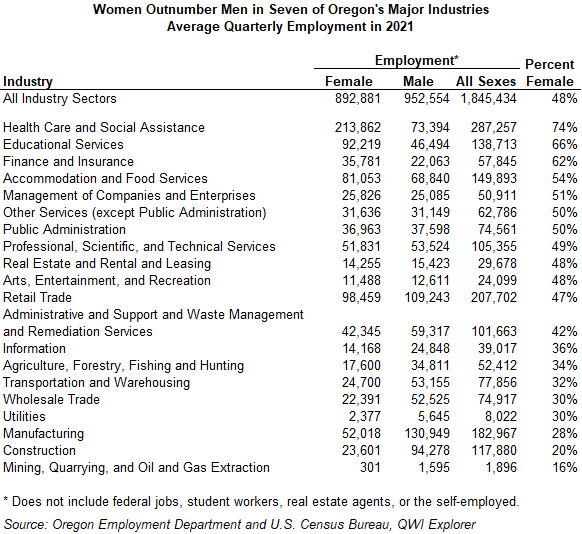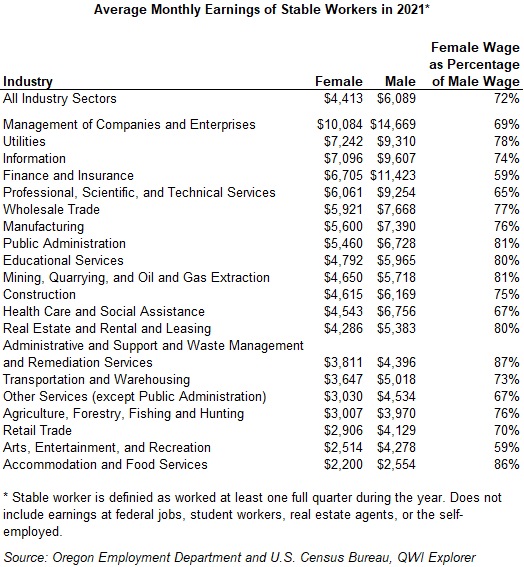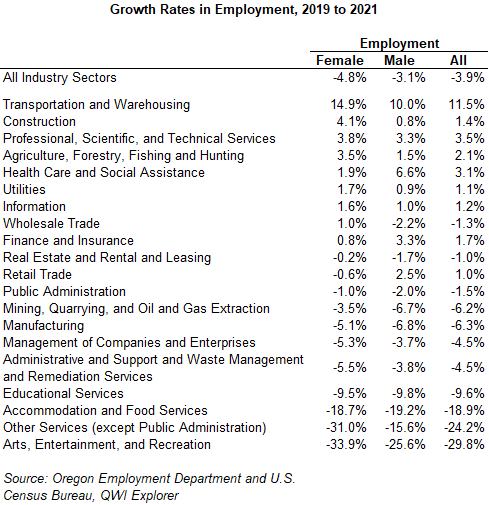Where Women Work and How Much They Earn in Oregon
March 10, 2023More than 890,000 jobs in Oregon businesses or state and local governments were held by women in 2021. Women represent 48% of employment in Oregon, but the share of jobs held by women varies considerably by industry. These figures come from 2021, when the Oregon economy was still recovering from the 2020 Pandemic Recession before Oregon recovered all payroll jobs in aggregate in late 2022.
Women’s average earnings were $4,413 per month in 2021, an inflation-adjusted growth rate of 7.3% from 2019, averaging 3.6% in the two years. This continues a trend of growth in women’s wages that has exceeded the growth of total wages throughout the United States. For comparison, men’s average earnings grew 4.2% to $6,089 from 2019 to 2021, averaging 2.1% annual growth over the two years. Earnings for women, just like employment, vary by industry.
A note on the use of sex in this article: While gender is a spectrum, this article only uses the two binary sexes “female” and “male.” The data referenced in this article is from the Census’ Quarterly Workforce Indicators (QWI), which sources their sex data from the Social Security Administration. While sex identification on a Social Security document can be binary or non-binary, Social Security’s record system can only designate a person as either female or male.
Women’s Employment by Industry
Women outnumbered men in seven of Oregon’s 20 major industry sectors. Women held the highest percentage of jobs in health care and social assistance, holding nearly three out of every four jobs. Other industries with a high percentage of female employment include educational services (66%) and finance and insurance (62%). In contrast, women hold the lowest percentage of jobs in the industries of mining, quarrying, and oil and gas extraction (16%) and construction (20%).

The health care and educational services industries not only have the greatest share of jobs held by women, but also top the list for greatest number of women employed in all of Oregon’s industries. More than 213,000 jobs in health care and social assistance were held by women, while just over 92,000 women were employed in educational services. While retail trade employs more men than women, the industry employs the second largest number of women with over 98,000 jobs.
Women’s Average Earnings by Industry
Monthly earnings for women in 2021 averaged $4,413. The industries where women earned the highest average income were management of companies and enterprises ($10,084), utilities ($7,242), and information ($7,096). These industries have a higher average wage overall, regardless of sex. Industries where women earned the least in terms of average income were accommodation and food services ($2,200); arts, entertainment, and recreation ($2,514); and retail trade ($2,906). Similarly, these industries tend to have a lower average wage overall.

In every industry, average monthly earnings for women were lower than men’s earnings. Women’s earnings as a percentage of men’s ranged from a relatively close 87% in administrative and support and waste management and remediation services to 59% in finance and insurance. There are many factors behind these disparities in earnings, such as the number of hours worked, the relative wages of occupations with higher concentrations of women within these industries, and the propensity for women to hold or be promoted into management positions with higher rates of pay. Unfortunately, that information is not available from this particular data source, but is explored later in this article looking at external data sources.
Trends in Women’s Employment
Total average annual employment decreased (-3.9%) from 2019 to 2021 because of fall-out from the Pandemic Recession. The rate of employment loss for women (-4.8%) from 2019 to 2021 was slightly larger than that for men (-3.1%). Employment trends by industry for women tended to follow larger industry trends. Women’s employment growth was the highest in transportation and warehousing (14.9%); construction (4.1%); and professional, scientific, and technical services (3.8%). Employment among women decreased the most in arts, entertainment, and recreation (-33.9%); other services (-31.0%); and accommodation and food services (-18.7%).

People with lower wages were more likely to lose employment and stay unemployed in 2021. Industries that had larger dips in employment tended to see larger increases in average earnings than industries with stronger employment patterns. Because of these composition issues, it is hard to say anything definitive about wage growth from these figures.
The Wage Gap
The above data provide industry detail about the earnings of women and men in Oregon not available from other sources, but they do not explain why women have smaller paychecks than men on an aggregate level. On average, women in Oregon earn 72% of what men earn (not accounting for hours worked or type of job). This is up only 7 percentage points from 2011, when women earned 65% of what men earned, on average. While this is an improvement, the wage gap endures. There are a multitude of reasons for this, two of which are explored below: Hours worked and lack of representation in upper management.
Difference in hours worked partially explains the wage gap. According to an article published by the Bureau of Labor Statistics, women in the U.S. who were full-time wage and salary workers had median weekly earnings that were 83% of the median earnings for men who were full-time wage and salary workers in 2021 — notably more than the 72% for all workers in Oregon. One big reason for the discrepancy in hours worked is child care. According to a 2023 study by Pew Research, women with a child at home tend to be less active in workplace or work fewer hours than women without a child at home. Men, however, tend to be more active in the workplace and work more hours with a child at home. Additionally, Pew notes, “Women who experience breaks in their careers after becoming mothers sacrifice at least some of their earnings.”
A lack of equal representation of the sexes in upper management positions (significantly higher paying jobs) also partly explains why average earnings of women are less than the average earnings of their male counterparts. A 2022 analysis from McKinsey & Company, a management consulting firm, examines how COVID-19 has affected women in the workplace at the national level. They found that fewer and fewer women are employed in management positions as you move up the corporate ladder. At the start of 2022, 48% of entry-level managers surveyed were women, while only 26% of “C-suite” managers (e.g. CEO, CTO, CFO, etc.) were women.
There are many other economic factors that contribute to the enduring wage gap not covered here. Pew (in their study referenced above) looked at other factors such as discrimination, differences in education, and the “fatherhood wage premium.” The Oregon Employment Department looked at the effects COVID-19 had on women’s employment in Oregon in its study: Disparate Impact: COVID-19 Job Losses by Sector and Gender in Oregon.
Employment and Earnings for Transgender and Non-binary Workers
Currently, neither the Bureau of Labor Statistics (BLS) nor the Census Bureau collects gender identity for employment measurement purposes. As mentioned above, the QWI data used in this article uses sex data from the Social Security Administration. The BLS and Census have assessed the feasibility about asking about gender identity in the Current Population Survey (CPS; the survey the U.S. uses to measure unemployment), but there are currently no plans to ask about gender identity in the CPS.
While there are no official government measures of employment and earnings for transgender and non-binary workers, there are several other private organizations that do research on the topic. Though, it should be noted that this type of research is from relatively small sample sizes compared with the near-universe counts that make up the Census’ Local Employment Household Dynamics (LEHD) dataset.
In 2015, the National Center for Transgender Equality estimated from a sample that the unemployment rate for transgender residents in Oregon was 12%. This is more than double the unemployment rate of 5.5% for all residents in Oregon in 2015.
Research by the Human Rights Campaign estimates the U.S. 2021 median weekly earnings for transgender men is $700 (about 70% of the typical U.S. worker), $600 for transgender women (60%) and $698 (70%) for non-binary workers.
Employment and Earnings by Sex Data
Information about employment and earnings by industry and sex is from the U.S. Census’s Local Employment Household Dynamics (LEHD) partnership with the states. LEHD provides the most comprehensive data available for employment and earnings of women and men at the state and county level. Employment data is the average of quarterly employment for 2021. Earnings are the average of quarterly earnings in 2021 of workers who worked at least one full quarter during the year.
To explore and use the data available from LEHD, visit lehd.ces.census.gov.